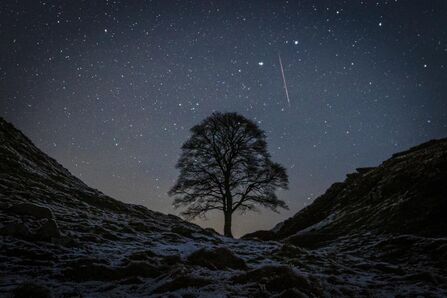This is the prime stargazing season across the UK, when the sun rises on the year’s shortest day and the nights are at their darkest.
We also have one of the spectacles of Mother Nature to look forward to – the Geminids meteor shower.
Milky Way © Ed Marshall
This is the prime stargazing season across the UK, when the sun rises on the year’s shortest day and the nights are at their darkest.
We also have one of the spectacles of Mother Nature to look forward to – the Geminids meteor shower.

Geminid at the Sycamore Gap © Wil Cheung
This amazing outbreak of shooting stars is caused by debris from the asteroid Phaethon burning up in the earth’s atmosphere. Other showers are triggered by cometary debris, but this shower is the undisputed king of them all! If you live under dark skies you’ll be in for a treat, but brighter ones can be seen from urban areas.
The shower peaks overnight on 13 and 14 December, but meteors can be seen in the days before and after this.
To see them use your naked eye, wrap up warm, and look high in the south east. Let your eyes become attuned to the night and be patient. Mulled wine is an optional extra.
Depending on how much light pollution you have, the Milky Way can be seen soaring overhead early evening – great for viewing. This narrow band of light is the edge on view of our own galaxy, but needs reasonably dark conditions to be seen.
To give you a sense of what I mean, it’s estimated that 80% of Brits can’t see it from where they live.
Amongst their number was a couple who came along to a stargazing session in the Yorkshire Dales a few years back. It’s a perfect location, except on this night a stubborn layer of cloud had parked over us.
As I trotted out the apologies the sky overhead parted like the Red Sea. The river of light flooded straight through, causing everyone present to take a sharp intake of breadth. It’s a spontaneous reaction that still brings a smile to my face.
Whilst light pollution is a bane for stargazing, it’s a more serious threat to wildlife. According to the Globe at Night project*, the planet’s night sky is brightening by nearly 10% per year. If that continues it’s estimated that a child born today under 250 stars, will see only 100 when they reach 18. For nocturnal creatures like moths – a key pollinator – that spells the threat of further declines. We can do our bit by being careful with our use of external lighting at night. Well-shielded and warm-coloured lights are all part of the answer.
The good news is you can see the moon and bright planets like Jupiter and Saturn just as well from the city as you can from the countryside. But if you want to see lots of stars then viewing from darker spot is definitely recommended. To help find your way around use a planetarium app on your phone.
This moves with you and shows you what you’re looking at. Free apps are available such as Google Sky Map, and Stellarium Mobile and they are a godsend. Start by identifying the brighter stars.
Before you buy a telescope, use binoculars instead – 7 x 50 or 10 x 50 sizes are the best for stargazing. They will reveal craters on the moon and winter star clusters like the Pleiades.
Get dark adapted by avoiding white light. It takes twenty minutes for your night vision to kick in. A red head torch is handy as this doesn’t have such a negative effect on our eyes.
If you have a modern smartphone you could start with this. Some even have inbuilt astrophotography functions. The Northern Lights and Milky Way are possible targets if you use a tripod. If you want to go further and take pictures through a telescope then it’s a good idea to pop along to your local astronomical society.
So embrace the season, dress in layers and come over to the dark side.
Richard Darn is a lifelong stargazer, who also helps some of the UK’s darkest landscapes retain their starry skies.
* Science, 19 January 2023
www.science.org/doi/10.1126/science.abq7781
Christopher C. M. Kyba, Yiğit Öner Altıntaş Constance E. Walker and Mark Newhouse